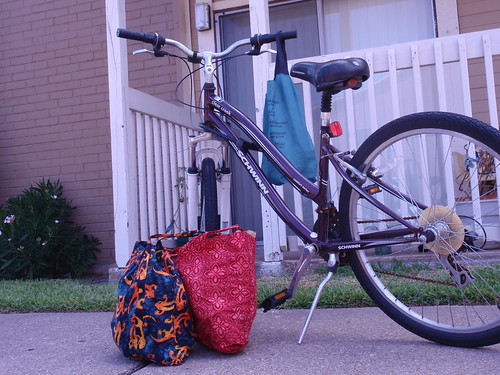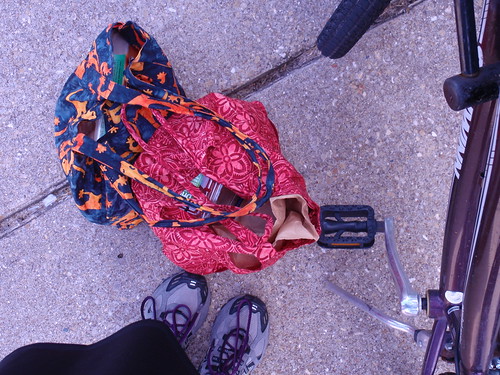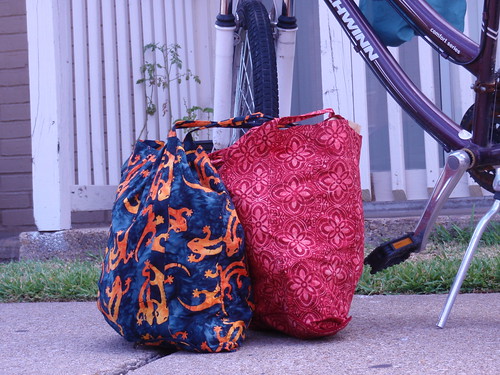One fun fact about me that you may not know if you don’t read my running blog or know me in person is that I don’t have a car. In fact, I’ve never had a car. The reasons for that are many, but the short version is that I never got a license to drive independently as a teenager. Because I never had a car, I never got used to having a car, which means I’ve never relied on the speed and convenience of a car. Over the years, I’ve used my feet, a bike, and public transportation to get around on my own. I’ve also had very generous friends with cars who have taken care of me by offering rides. I am grateful to have wonderful friends, but I do think it’s fair to say that for the most part, I’ve relied on myself to get around and get things done.
Today I thought I’d share with you some insights into how I manage to remain carless even in Texas, where for most people, I think it’s almost unfathomable not to have a car. I’ve chosen to remain carless so far because it saves me a ton of money, my job here is not stable at all, and it is possible to live in my town without a car. Allow me to explain.
I live in College Station, Texas. It’s a small city—certainly not rural Texas—and I live within easy biking distance of two good grocery stores: Brazos Natural Foods and HEB. I like BNF for my organic groceries and a lot of basics, like onions, garlic, coconut milk, canned tomatoes, thick-cut rolled oats, and sugar. BNF is a tiny, local store, and with limited space comes a limit in selection. I love BNF for what it does have, so I try to get over there every Saturday for a good grocery haul. The pictures above are from today’s trip, which was close to $60 in groceries. (The reason the total is so high for only two bags of groceries is that among other things, I bought eggs, half-and-half, cheese, fresh raspberries, and toothpaste, which are all a bit pricey. Also, the guy ringing up my groceries was new, and I think he may have made a mistake or two on my bill. Oh well.)
I go to HEB for its wider selection of produce and because HEB is open later in the evening. HEB has a lot of good organic stuff too, and I’m grateful to have one close to me.
My grocery habits generally require two trips per week, one to BNF on Saturday and one to HEB on Tuesday or Wednesday. Being on a bike means that I have to be mindful of how much I’ve bought—the heavier the load, the more difficult the ride home. I think this works to my advantage because it means I don’t buy much stuff that’s not on my list. I buy what I’ll eat, and I eat what I buy. Without a car, I can’t make quick trips to the store, so when I cook, I have to make do with what’s on hand.
I use two basic strategies to keep my cooking life flowing: I pick a recipe or two and buy ingredients, and I keep a supply of staple ingredients on hand. I always like to have onions, garlic, canned tomatoes, some beans or lentils, cheese, a fresh green, and rice or bread on hand. If I have those basics on hand, I know I can create something delicious any night of the week. My spice collection always comes out to play here too!
A how-to post like this one demands a few tips in list form, so here are a few tips that work for me to do almost all my grocery shopping via bicycle:
* Invest in a sturdy bike. I love my Schwinn cruiser. It’s very solid and comfortable for riding around with bags of heavy groceries.
* Be realistic about what you can haul home. Much of this will depend on you and your level of strength, but a good gauge is the weight of your shopping basket. When it starts becoming too heavy for me to haul around the store, I know I am awfully close to my limit for what I can manage on my bike.
* Along those same lines: beware the heaviest items. I buy a half-gallon of almond milk every week, and I try to avoid buying too many canned goods or bottles of wine if I’ve got almond milk on my list for that day.
* Buy fresh stuff. Fresh produce has less packaging, so it’s lighter in weight and easier to haul home. Plus it’s delicious, so why wouldn’t you buy fresh produce? It can, however, be a bit delicate, so be mindful of how it’s packed into your bags. Sadly, my bananas are often bruised during the ride home, so now I try to position them so they’re less likely to get bumped and thumped.
* Invest in good reusable shopping bags. Over the years, I’ve gone through many of these bags. The best rule here is that you pay for what you get. If the bags are cheap, they probably won’t last too long. I’ve had cloth or plastic reusable bags from Whole Foods, Target, and HEB, and none of them are great for hauling groceries on a bike. My newest investment is a pair of wrapsacks. My sister-in-law got them for me, and so far, they are awesome. I’ll write a bit more about them in my next post. For now, here they are, sitting next to my bike. Aren’t they adorable?
* Reward yourself for your hard work. Because I save so much money by not having a car, I feel okay splurging at the grocery store. My favorite treats are fresh fruit, bakery bread, chocolate bars, bottles of wine, a nice cheese, and those individual Greek yogurts. That list may sound awfully healthy, but honestly, most of the food I eat is cooked from scratch, so anything that can be eaten straight from the package is a treat.
* Finally, I will contradict myself. If you really need to do a big grocery haul, don’t be afraid to pay for a cab ride or to bribe a friend to take you shopping. I sometimes need more groceries than I can handle on my bike, so I’ll take the bus to HEB, do my shopping, and then take a cab home. The cab ride costs $13-15, which is worth it for the convenience of buying a lot of food in one trip.
A word about my bike here: I do not have a basket or any sort of gear for hauling stuff. I imagine that having something along those lines would be awesome; I just haven’t gotten around to purchasing and installing some gear. I make do with my wrapsacks, my shoulders, and my handlebars.
Any questions for me about hauling groceries on a bike? Any other questions about the carless lifestyle?
PS This post was not sponsored by any of the stores or products mentioned here, even though I would not be opposed to accepting their sponsorship of this blog!




3 comments:
I don't like to put grocery bags on my handlebars - I find it affects the handling of the bike too much, and makes it hard to steer. I also hit a bag into my front wheel one time, and almost ran into a moving car. So I don't do it anymore. I either use a backpack, or if I have really a lot, I put a milk crate on my rear rack. The weight doesn't seem as troublesome when loaded on the back end of the bike.
Great post! We are a one car family, but Nathan uses the car for work all day, so I'm pretty much without for most of the week. I do have a scooter, and I've gotten pretty good at grocery shopping on that - though I would say it's definitely easier to transport things on a scooter than on a bike!
I admire your ingenuity when it comes to be being car-less in Texas!
That's a good point, Jess. With my wrapsacks, I tend to put my groceries on my shoulders because they swing too much on the handlebars. A backpack is a great idea too--my friend Ammie swears by her backpack for grocery shopping :-)
PS Montague bikes, want to sponsor this blog? E-mail me at lifeloveandfood {at} gmail {dot} com. You know we'd be a great fit! And I have great rates for advertisers, too.
Your scooter is too cute, Chrissy! I love it. You sound like you are in the same boat as me where you have some wheels to get around, but it's not a car. On a scooter, you're still exposed to the elements, and I'd imagine you need to be very careful about the car traffic.
Post a Comment